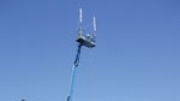BSI's distributed RF system
One of the biggest challenges to producing a live multi-venue event is coordinating all of the wireless signals and getting them back to the production truck in a sustainable (and usable) fashion. This is no easy feat for events like a NASCAR race or ESPN's X-Games, where a myriad of wireless camera systems and audio signals must travel long distances and be brought back to a central location — without interference or the signals breaking up.
A company in Hanover, MD, called Broadcast Sports, Inc. (BSI) — which has worked on virtually every major sporting event in the U.S. — knows a thing or two about wireless transmission and reception.
When it was challenged with managing the signals from four separate venues for the 2012 ESPN X-Games at Buttermilk Mountain in Aspen, CO, it immediately knew the solution: deploy an “intelligent diversity, distributed receive infrastructure,” whereby a ring of receive boxes is installed around a desired coverage area and picks up the signals of a camera or wireless mic crossing its path. The camera operator simply moves from one box to the next, and his or her signal is passed off between them and then on to a fiber transceiver (made by Ortel). The fiber transceiver converts the RF spectrum into light and then sends it via fiber cable to the BSI mobile unit on site. Crews then provide one clean feed of every camera and microphone at the event, and the director then chooses among them.
During the X-Games, BSI outfitted three separate “hoop” systems with a 3-D Toshiba FollowCam, monitor and transmitter for use during the SlopeStyle, Pipe and Big Air events. Three experienced skiing camera operators captured the action live in 5-D from the center of the pipe. For faster, downhill events like the Snowboarder X and Skier X, technicians attached a transmitter and remote control system to a FlyCam that operated along the course more than 30ft above the ground and traveled at speeds up to 75mph. The production team had full (remote) control of the pan, tilt and paint functions of the FlyCam rig from the ground.
Making sense of RF

Clay Underwood, technology development manager at BSI, said the system is actually made up of two parts: the ring of receivers and an intelligent diversity system that is used to select (at thousands of times per second) which bits of data they want to pass on to decode inside a dedicated BSI production truck on-site. These numerous feeds are then made available to the director overseeing the entire live broadcast inside the main production truck.
The unique BSI infrastructure can work with any DVB-T compliant wireless camera or mic transmitter. The receive boxes, developed and made by BSI, are capable of working within the 1.4GHz to 1.5GHz and 2GHz to 2.5GHz spectrum, depending upon what's available at the time. The box receives the RF signals at their native microwave frequency, downconverts them to UHF, converts them to light, and using special hardware made by BSI (that performs filtering, amplification and other “magic”) brings two discreet slices of spectrum back to the truck over a single-mode fiber cable.
The professional video industry's #1 source for news, trends and product and tech information. Sign up below.
In the case of the 2012 X-Games production, each element was composed of two signals — one 2-D (left eye) and one 2-D (right eye) signal — that together deliver the 3-D experience. To save on production costs, ESPN has pioneered new ways of acquiring footage for both live telecasts simultaneously. (ESPN called it a “5-D” production, whereby it used the left-eye view as the typical HD telecast.) Sending the 3-D portion was not a problem, Underwood said, as in essence they were only sending a pair of synchronized 1080i59.94 HD signals over a receive infrastructure that is designed to deliver multiple elements. Ensuring that the signals were perfectly in sync at all times was a tougher issue to tackle.
“We spent several years developing a dual HD-SDI stream miniature transmitter that ensures synchronicity from MPEG-4 encoding through transmission and into decoding,” Underwood said.
Intelligent RF switching
All of the hundreds of signals captured on-site are fed into a signal-processing card that makes the intelligent decision about where that signal is coming from and where it needs to be rerouted. The card also converts all incoming UHF signals to a single decodable ASI stream (from multiple locations). BSI typically brings racks of eight input receiver cards so that each one can receive signals from eight different sites. It can gang racks together using ASI switches, so the system can scale as needed. The system is also weather-agnostic, Underwood said, and has held up to harsh conditions in the past.
For the technical director in the truck, the BSI system appears seamless between locations. The camera operator (or wireless mic) easily moves from one coverage area to the next without losing signal strength or experiencing dropouts. Using fiber, the distance limitations of coax are eliminated, and Underwood said the BSI architecture can tolerate about a 4dB of loss in a run of fiber before you start to see the RF signal negatively affected.
BSI developed this “ground-based intelligent receive” capability for NASCAR about six years ago. At that point, it was using wireless cameras inside of the cars and — using a technique it calls “aerial repeating” — bouncing the signals off a helicopter circling overhead in order to get it back to the production truck. This method was tricky and expensive to get right every time, and there was a lot of trial-and-error for each venue.
“For the in-car cameras, we were using an analog system, and we couldn't tolerate the multipath artifacts and dropouts we were getting,” Underwood said. “As soon we moved to a digital solution for the in-car cameras, we were able to build a ground-based solution because there, multipathing is not as big an issue.”
Rock-solid reception
The system also works well inside buildings, allowing a camera operator to move (while continuously shooting) from the field to the locker room without losing a signal. In this case, a series of receive points can be set up along the route the camera operators is supposed to take. And multiple cameras can use the same distributed architecture.
After six years, Underwood said the system is mature and quick to set up. BSI has 13 production trucks in total, which are all pre-configured before they get to an event, and then the boxes are dropped on-site as needed. At the X-Games production, the company set up seven diversity receive sites around the four disparately located venues on Buttermilk Mountain, which took about two days to deploy and test the system. It worked perfectly for the entire four-day event in January.
Underwood said the “magic” of the system lies in BSI's intelligent diversity receivers, which use both maximum ratio combining and packet switching diversity. As long as you can get all of that RF spectrum back to the truck intact, the brains in the diversity receive system can handle it.

Michael Grotticelli regularly reports on the professional video and broadcast technology industries.
